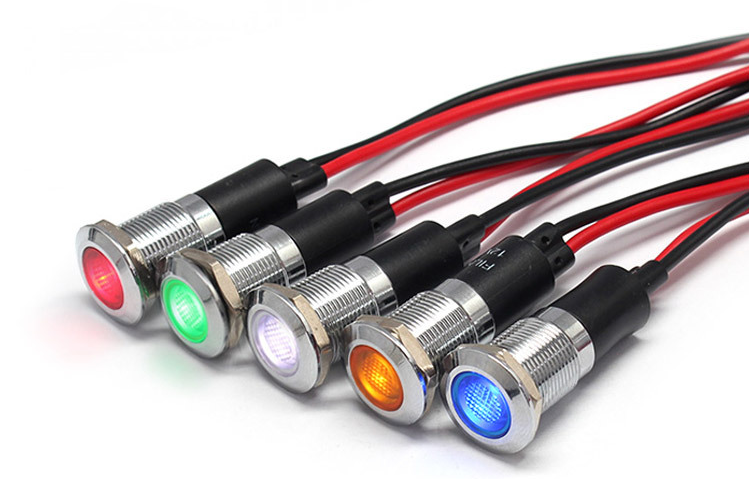
Overview of LED Indicator Lights
LED indicator lights, also known as light-emitting diodes, are tiny luminous indicators that emit light when an electric current passes through them. They are fundamentally different from traditional incandescent bulbs in that they do not have a filament that wears out. Instead, they are semiconductor diodes that glow when a voltage is applied. Due to their small size, longevity, and energy efficiency, they have become the go-to choice for many applications across industries.
Importance of Sourcing from China
China has grown immensely in the last few decades as a global manufacturing hub, particularly in electronics and lighting industries. The Chinese LED industry has experienced exponential growth, becoming a world leader in both manufacturing and supply. Several factors have contributed to this:
-
Infrastructure and Technology: China has heavily invested in infrastructure and technology, making the production of LEDs more efficient and advanced.
-
Labor and Production Costs: The labor cost in China remains relatively lower than in many Western countries. Coupled with the bulk production capabilities, this leads to a significant reduction in the cost of manufacturing.
-
Government Support: The Chinese government has implemented policies that encourage the growth of the LED industry, offering tax incentives, subsidies, and grants to manufacturers.
The main objective of this article is to highlight the benefits of importing LED indicator lights from China. While many may have reservations or uncertainties about importing, it's essential to understand the advantages and potential challenges. By exploring the intricacies of the Chinese LED market, supply chain considerations, and cost-benefit analysis, this article aims to provide a comprehensive guide to businesses and individuals considering sourcing LED indicator lights from China.
Understanding LED Indicator Lights

LED Indicator Lights are a subset of the broader LED (Light Emitting Diode) category, designed specifically to signal or indicate a certain function, state, or warning. Unlike conventional light bulbs that serve primarily as a light source, LED indicators function as communicative devices in electronics, machinery, or appliances. Their primary role is to provide visual feedback, such as when a device is switched on, when a machine has completed its cycle, or when there's an error.
Types of LED Indicator Lights
-
Panel Mount LEDs: As the name suggests, these are LEDs designed to fit into panels, offering a seamless look. They are commonly seen on instrument panels, industrial machines, and control consoles. The front side is usually dome-shaped, providing a clear visual indication, while the rear end has pins or leads that connect to the circuitry.
-
PCB Mount LEDs: Designed specifically for mounting on Printed Circuit Boards (PCBs), these LEDs come with short leads that can be soldered directly onto the board. They are commonly used in electronics like mobile phones, tablets, and other compact devices where space is a constraint.
-
Through-Hole LEDs: These are cylindrical LEDs with long leads that can be threaded through holes in PCBs and then soldered into place. Their design allows them to stand erect on the board. This type is popular in hobbyist projects and prototyping due to their ease of use.
-
Surface Mount LEDs: SMD (Surface Mount Device) LEDs, or simply Surface Mount LEDs, are tiny and flat. They're designed to be mounted on the surface of PCBs rather than through holes. Given their small size, they're common in modern electronics, offering high luminosity in a compact space.
Applications of LED Indicator Lights
LED indicator lights are omnipresent, and their applications are vast. Some of the common applications include:
-
Electronics: Indicator lights in gadgets signal battery life, connectivity status (Wi-Fi, Bluetooth), and notifications.
-
Machinery: In industrial machines, these lights indicate operational statuses, warnings, or completion signals.
-
Automobiles: Indicator lights on dashboards convey information about fuel levels, engine health, and other vital parameters.
-
Home Appliances: From microwave timers to washing machine cycles, LED indicators guide users through operations and signal completion or errors.
-
Public Signage: LED indicators in public transportation, elevators, and traffic signals convey critical information to masses.
The Chinese LED Industry

The Growth of LED Manufacturing in China
Over the past few decades, China has emerged as the epicenter of LED manufacturing, driven by rapid technological advancements, extensive research, and supportive governmental policies. Factors like abundant labor, vast industrial zones, and a vast internal market have further fueled this growth. Today, China accounts for a significant portion of the global LED production and export.
Key Players in the Chinese LED Market
Some of the major names in the Chinese LED market include Opple Lighting, MLS Co. Ltd., NationStar, Foshan Lighting, and Refond. These companies have a significant share in both domestic and international markets, producing everything from LED indicator lights to LED bulbs and fixtures.
Quality Standards and Certifications
To ensure the quality of LEDs produced, Chinese manufacturers adhere to both national and international quality standards. Certifications like ISO 9001, RoHS (Restriction of Hazardous Substances), and CE (European Conformity) are commonplace. Furthermore, specialized certifications, specific to LED products, ensure energy efficiency, performance, and safety. The China Quality Certification Center (CQC) and the China National Accreditation Service for Conformity Assessment (CNAS) are among the primary bodies overseeing these standards in China.
Advantages of Importing LED Indicator Lights from China

Cost Efficiency
-
Competitive Pricing: One of the primary reasons businesses look to China for sourcing LED indicator lights is the competitive pricing. Given the abundant raw material availability, labor force, and technological advancements, Chinese manufacturers can offer products at prices that are often unbeatable by manufacturers in other regions.
-
Economies of Scale: Chinese manufacturers, especially the leading ones, operate at massive scales. This volume of production means that the per-unit cost is reduced significantly. When importing in bulk, businesses can further negotiate prices, driving down costs.
Wide Range of Products
China's vast LED market caters to a diverse set of requirements. Whether you're looking for basic LED indicator lights, RGB LEDs, or specialized industrial indicator lights, the chances are that multiple suppliers in China can meet the demand. This variety ensures that importers can find the exact product specifications they need.
Customization Options
Chinese manufacturers are adept at offering customized solutions. This means that if a business has a specific design, color, or functionality in mind for LED indicator lights, manufacturers can adapt their production to meet these unique requirements. Custom branding, packaging, and other specific needs can also be addressed.
Quality Control Measures
-
ISO Certification: Many Chinese LED manufacturers are ISO-certified, meaning they adhere to international standards for quality and management. ISO 9001, in particular, assures that the manufacturer has processes in place to maintain product consistency and quality.
-
Quality Inspection Processes: Before shipping, products typically go through rigorous quality inspection processes. Some businesses also hire third-party inspection services to ensure that the LED indicator lights meet their standards. These quality checks are a testament to the commitment of Chinese manufacturers to deliver high-quality products.
Supply Chain Considerations

A. Logistics and Shipping
China has a robust infrastructure in place to support international trade. Ports like Shanghai, Shenzhen, and Ningbo are among the busiest in the world, ensuring that products are shipped out efficiently. However, importers must be aware of shipping costs, potential delays, and choose the best shipping method (air, sea, rail) based on their needs.
B. Import Regulations and Compliance
Before importing LED indicator lights, it's essential to be aware of the import regulations in both China and the destination country. This includes understanding duties, taxes, and any product-specific regulations. Proper documentation, including product certifications, is crucial to ensure a smooth customs clearance process.
C. Communication and Language Barriers
While many in the Chinese business community speak English, especially in international trade, language can sometimes pose a challenge. It's beneficial to have a translator or a local agent who can facilitate communication. Additionally, understanding the nuances of Chinese business culture can play a pivotal role in building strong relationships with suppliers.
Finding Reliable Chinese Suppliers
A. Researching Potential Suppliers
The first step in sourcing from China is to identify potential suppliers. Trade fairs, such as the Canton Fair, are an excellent starting point as they bring together a vast array of manufacturers. Online platforms like Alibaba, Made-in-China, and Global Sources also provide extensive listings of suppliers. When browsing these platforms, consider:
-
Supplier's product range
-
Years in business
-
Client testimonials and reviews
B. Supplier Verification
Once potential suppliers are identified, the next step is verification. This ensures that you're dealing with a legitimate and reputable company. Some methods for verification include:
-
Checking business licenses and registration
-
Visiting the manufacturing facility in person or through a trusted agent
-
Requesting references or case studies from the supplier
C. Evaluating Supplier Credibility
After verification, further evaluate the supplier's credibility by considering:
-
Their responsiveness to communications
-
The clarity and comprehensiveness of their product documentation
-
Their willingness to provide samples
-
Any industry awards or recognitions they've received
D. Negotiating Terms and Contracts
Once a supplier is shortlisted, the next step is to negotiate. Key points to consider during negotiations include:
-
Pricing and volume discounts
-
Payment terms (commonly T/T, Letter of Credit)
-
Delivery timelines
-
Warranty and after-sales support
-
Provisions for quality inspections
Always ensure that agreements are documented in a formal contract. It's advisable to have the contract reviewed by a legal expert familiar with Chinese business laws.
Overcoming Common Challenges
A. Quality Assurance
Ensuring consistent quality is a primary concern when importing. To mitigate risks:
-
Clearly define quality parameters with the supplier
-
Conduct regular inspections, either in-house or via third-party services
-
Maintain open communication with the supplier about quality expectations
B. Intellectual Property Protection
Protecting intellectual property (IP) rights can be challenging, especially in a foreign market. Steps to protect IP in China include:
-
Registering IP rights in China, as the country operates on a "first-to-file" system
-
Ensuring non-disclosure agreements are signed when sharing proprietary designs or concepts
-
Staying informed about Chinese IP laws and regulations
C. Lead Times and Production Delays
Production delays can impact the supply chain and lead to potential losses. To manage this:
-
Maintain clear communication with the supplier about production schedules
-
Plan orders well in advance, factoring in potential delays
-
Establish contractual provisions for late deliveries
-
Consider maintaining a buffer stock or working with multiple suppliers to mitigate risks
In conclusion, while there are numerous advantages to sourcing LED indicator lights from China, it's crucial to approach the process methodically. By researching, verifying, and building strong relationships with suppliers, businesses can tap into the vast potential of the Chinese LED market while mitigating potential risks.
Cost-Benefit Analysis

A. Calculating the ROI of Importing LED Indicator Lights
The Return on Investment (ROI) is a crucial metric when determining the financial viability of importing LED indicator lights from China. Here's a basic approach:
-
Initial Investment: Factor in the total cost of purchasing, including unit price, shipping, customs duties, taxes, and any third-party inspection or certification costs.
-
Operational Costs: Include ongoing expenses such as storage, inventory management, marketing, and distribution.
-
Gross Profit: Calculate the expected selling price in the target market minus all costs associated with the product.
-
ROI Calculation: ROI=(Net Profit from Sales−Initial InvestmentInitial Investment)×100%
B. Factors Impacting Cost Savings
Several factors can impact the overall savings when importing:
-
Volume Discounts: Buying in bulk often results in substantial price reductions.
-
Currency Fluctuations: Changes in currency exchange rates can either increase costs or yield additional savings.
-
Shipping Methods: Choosing between air, sea, or rail freight impacts both cost and delivery time.
-
Customs and Duties: Different countries may have varying tariffs, which can add to the total cost.
Sustainability and Ethical Considerations
A. Environmental Impact
LEDs, in general, are more environmentally friendly than traditional bulbs, consuming less power and having a longer lifespan. However, when importing:
-
Consider the carbon footprint associated with shipping. Sea freight typically has a lower footprint than air freight.
-
Evaluate the supplier's environmental policies, such as waste management and energy consumption.
B. Ethical Manufacturing Practices
When sourcing products from overseas:
-
Ensure that the supplier adheres to fair labor practices, including no child or forced labor.
-
Inspect working conditions either in person or through third-party audits.
-
Opt for suppliers who have certifications indicating compliance with international labor standards.
Warranty and After-Sales Support
A. Understanding Warranty Policies
Warranty terms vary among suppliers. Ensure that:
-
Warranty duration and terms are clearly stated.
-
The process for claiming the warranty is well-defined.
-
Provisions cover both product replacement and repairs.
B. Resolving Issues and Returns
Dealing with product issues or returns can be more complicated when dealing internationally:
-
Clearly communicate with suppliers about return and replacement policies.
-
Determine who bears the shipping cost in case of returns.
-
Establish a local repair or service center if feasible, to address minor issues without returning products to China.
By being meticulous in assessing costs, ensuring ethical sourcing, and understanding warranties, businesses can make informed decisions that are not only profitable but also responsible.
Case for Long-Term Partnerships
A. Building Strong Relationships with Suppliers
Building a long-term relationship with Chinese suppliers goes beyond transactional interactions and can lead to numerous advantages:
-
Trust: As with any relationship, trust is foundational. Over time, consistent dealings and open communication foster trust, enabling smoother negotiations and quicker problem resolution.
-
Predictability: Familiarity with a supplier's processes, quality standards, and business ethics minimizes surprises. It also streamlines procurement processes.
-
Feedback Loop: Long-term partnerships mean continuous feedback, helping both parties innovate and improve.
-
Cultural Exchange: Over time, businesses understand cultural nuances, fostering mutual respect and smoother communication.
B. Loyalty Benefits
Loyal business relationships often result in:
-
Priority Treatment: Trusted partners often get priority during peak production times or when supplies are limited.
-
Negotiation Leverage: Loyal customers may receive better terms, discounts, and early access to new products.
-
Flexibility: Suppliers might offer more flexible payment terms, customizations, or support to long-term partners.
-
Joint Ventures: Sometimes, prolonged partnerships lead to more substantial collaboration, such as joint ventures or exclusive distributor agreements.
Summary of Benefits
A. Recap of Key Advantages
-
Cost-Efficiency: Competitive pricing and economies of scale make importing LED Indicator Lights from China financially appealing.
-
Variety and Customization: The vast Chinese LED market offers a wide product range, coupled with customization opportunities that cater to specific business needs.
-
Quality Assurance: With robust quality control measures in place, including ISO certifications and inspection processes, businesses can be assured of product consistency.
-
Supply Chain Robustness: China's well-established logistics and shipping infrastructure ensures timely product delivery.
-
Long-Term Partnership Merits: Building lasting relationships with Chinese suppliers can yield loyalty benefits and operational predictability.
B. Why Importing from China Makes Sense
China's dominant position in the global LED industry isn't merely by chance. The combination of technological advancement, massive manufacturing capabilities, a competitive pricing structure, and adaptability to global market demands makes it a hub for LED Indicator Light sourcing. For businesses aiming to strike a balance between cost-efficiency and quality, turning to the Chinese LED market is not just an option; it's a strategic imperative.
Conclusion
A. Final Thoughts on Importing LED Indicator Lights from China
China's LED industry has seen exponential growth, driven by technological advancements, robust infrastructure, and a commitment to quality. Importing LED Indicator Lights from China provides businesses with a unique opportunity to access top-tier products at competitive prices. However, like all international business ventures, it requires thorough research, careful planning, and a focus on relationship-building.
B. Encouragement to Explore Opportunities in the Chinese LED Market
For those on the fence about Chinese LED market, consider the vast potential waiting to be unlocked. With the right approach and an eye for detail, businesses can not only expand their product offerings but also enjoy substantial profit margins. The journey might come with its set of challenges, but the rewards, both immediate and long-term, are well worth the effort. Embrace the opportunities and let China's LED industry illuminate your business's path forward.
FAQs
A. Common Questions About Importing LED Indicator Lights from China
1. Is it safe to source LED lights from China?
Yes, provided due diligence is done in selecting reputable suppliers and ensuring quality control measures are in place.
2. How do I ensure I'm getting a quality product?
Opt for suppliers with credible certifications, use third-party inspection services, and regularly audit manufacturing processes.
3. Are there minimum order requirements?
Most manufacturers have minimum order quantities (MOQs), which vary depending on the product and supplier.
4. How do I handle communication barriers?
While many Chinese suppliers have English-speaking staff, it's beneficial to have a local contact or translator, especially for complex negotiations or technical discussions.
5. What are the payment terms generally like?
Common terms include T/T (telegraphic transfer), Letter of Credit, and sometimes PayPal for smaller transactions.





